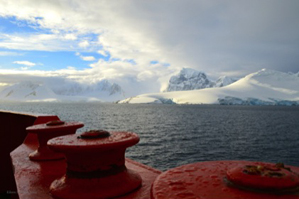Antarctic co-op: Adventures in fishing

This is a guest blog post by Eileen Sheehan, a biochemistry student at Northeastern University who is on co-op at Palmer Station, Antarctica. She will providing a series of guest blog posts about her co-op experience.
This is the story of my first Antarctic fishing adventure, in which we collected fish for all of our planned research experiments. It was a long and grueling night, but worth every minute of lost sleep.
The Laurence M. Gould research vessel is a vibrantly red 70-meter ship equipped with labs and used by the National Science Foundation for research in the Southern Ocean. We set out on a Saturday for Dallmann bay, where we went pot fishing for our red-blooded species, N. coriiceps and G. gibberifrons.
To get there, we passed through a beautiful area called the Neumayer Channel. It’s surrounded by picturesque white mountains, icebergs, and the occasional sea animal. As we neared Dallmann Bay, I actually got to see a large ice float with about 12 fur seals lounging in the sun.
We began dropping our (extremely large, bulky) pots around 2 p.m. Luckily we had a lot of assistance from the marine techs on board. They tied up a string of four pots and pushed each one individually overboard.
While the pots sat at the bottom of the bay, we headed over to Low Island, where we trawled the ocean floor for icefish, such as C. aceratus. The net first went into the water at 10 p.m. but didn’t reach the bottom for another fifteen minutes. We then trawled along the sea floor for twenty minutes, and it took another fifteen or so for the net to reach the deck. Early on in the night when all four cups of coffee were fresh in my system, the wait time didn’t seem too bad. But as we approached 4a.m., the night began dragging on. At least we had our midnight rations of hamburgers and Twix bars to give us a bit more energy for the night ahead.
As we waited for our nets to reach the water’s surface, we suited up in our lovely Gorton’s fisherman gear. For me, this included many layers of warm, waterproof clothing beneath a bright yellow rubber suit. Rubber gloves and rubber steal-toed boots also helped to keep us dry. We top it all off with a hard hat—the last thing that we would need while fishing is to have to deal with a concussed team member.
Once we got the net back on deck, the fun really began. We all ran to open it, spilling a huge amount of fish, sea stars, algae, skates, small octopuses, you name it, onto the ship. We dug through it all looking for the fish species we wanted. Once we found our different icefish and the occasional red-blooded species, we placed them in large foam buckets that we’d set up earlier.
Once we were done digging, the marine techs helped us clean up the remaining debris with our hands and, if you were lucky, a shovel. The other animals just got tossed overboard back to their homes. Then, we moved the fish in their temporary buckets to the larger tanks on board.
We tried our best to keep the number of fish in each tank low. Our icefish tend to be extremely sensitive creatures, so it’s important that we ensure that we don’t over-pack the tanks with animals. We wouldn’t want them to stress as that can lead to illnesses and even death. The goal is to keep them alive so that way we can bring them back to the station and begin our experiments.
After everything was cleaned up, the net went back into the water to trawl again…and again and again for a total of 13 trawls yielding nearly 80 individual fish.
The next day we headed back to Dallmann Bay to pick up the pots, which the marine techs collected with giant machines. When the pots finally emerged, we had to move quickly. We carried each one to the center of the deck to open it and remove our fish and bait bags. Our fish were placed in tanks along with those from the trawls.
By the time we finished removing all of the pots from the water, we had a few dozen fish. Between this trip and a few after it, we’ve collected more than fifty N. coriiceps and 99 G. gibberifrons as well. Needless to say, we have plenty of our favorite red-blooded fish on hand now to begin experiments.
Once this 24-hour fishing bonanza was complete, we steamed our way back to Palmer Station. When we reached the station, we were able to start the process of moving the fish into the station aquarium. But that’s a whole other process and adventure that I’ll share with you next week.










